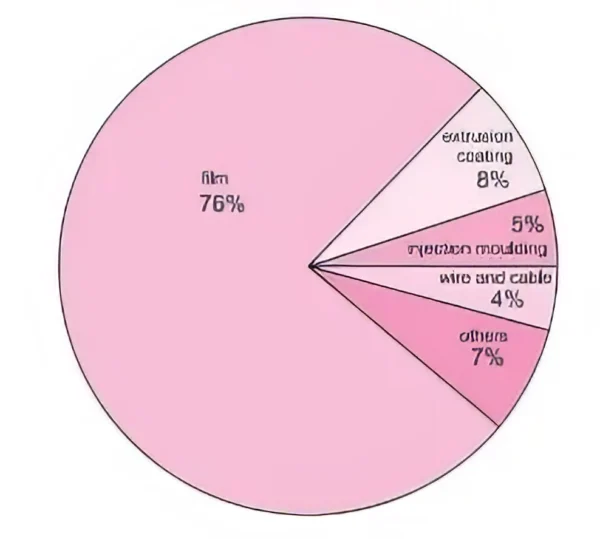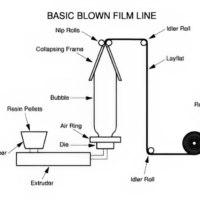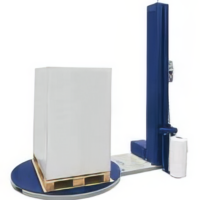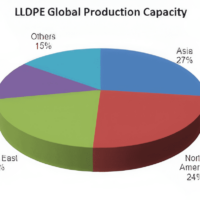What Is Low-Density Polyethylene? (LDPE)
In any packaging industry, there is a tendency not to think too much about the origins of our most favoured products. The humble cardboard box, for example, does not get more than a bat of an eyelid to its history and its production value when used on a daily basis. The same can be said for one of the giants of the packaging industry –pallet stretch wrap. Few industries buying this revolutionary product realise that there is far more on the surface of their stretch film than simply having a great quality answer for protecting pallets and boxes of products.
Thinking outside of the box, we can see that there is certainly a rich history behind every roll of industrial stretch film. Starting from the beginning – what is low density polyethylene, and how does it contribute to the production of today’s stretch wrap? LDPE is known for its flexibility, toughness, and corrosion resistance, making it a popular choice for various engineering applications.
Creating Low-Density Polyethylene through Free Radical Polymerization
Stretch wrap is often created using linear low-density polyethene (LLDPE). In the beginning of plastics manufacturing, low density polyethylene was more prominent in the industry, however it is now more widely used for containers and non-stretching plastic products commonly used in the food packaging industry. As seen below, however, polyethylene in both liner and low density forms are most commonly used for different films, alongside other products and industrial requirements.

Polyethylene is created from elements found in natural resources: crude oil and some natural gases. Funnily enough, it was a complete accident that LDPE was formed in the first place. Ethylene gas plays a crucial role in the production of LDPE, as it is separated from the raw petroleum mixture and circulated through a compressor before being injected with air or peroxide initiators to initiate polymerization reactions in the tubular reactor. Researchers from both Germany and Italy in 1952 by the names of Karl Ziegler and Giulio Natta managed to create an environment where a new catalyst was produced for the free radical polymerization of ethylene. The process they developed was appropriately named the Ziegler-Natta catalyst, and their research earned them a Nobel prize together in 1963. The new aluminium-based catalyst they discovered allowed for the creation of LDPE to be permitted under conditions of lower pressure than previous polythene production would allow.
Poly plastics are created where the monomer, in this case ethylene, is forced to break by the use of a catalyst to join the open chains together. The double bonds holding the carbon atoms in ethylene are forcibly broken by the energy produced with the use of the catalyst, thus making each atom open to singular bonding, creating a linear, connecting chain of carbon and hydrogen molecules. The product, therefore, ends up having incredibly straight molecular lines, as shown below.

What happens to make polyethene capable of becoming low-density? Minimal amounts of a co-monomer are added to the chemical stock. The result of the process adds new branches to the molecular chain at irregular intervals. Random polymerisation takes place, and the smaller branching chains in the structure are what give the LDPE its low-density structure. Long chain branching affects the sealing temperature, barrier properties, density, tensile strength, and resilience of the LDPE, making it crucial in the industrial production process. The example below shows the smaller chain branch created when copolymerised with butane to create LLDPE, a process applied with low pressure first by DuPont Canada in the 1950s.

In recent years, the addition of a new chemical to the polymerisation process has resulted in a new addition to the polyethene family. Metallocene linear low density polyethylene (mLLDPE) is created when the catalyst used is a metalocene chemical. The mass of the final product is able to be thoroughly controlled through this polymerisation method, and the film produced is able to be incredibly thin, usually used for wrapping delicate food items.
In the manufacturing process of pallet stretch wrap, the film does not start life as a soft, supple material like the one it turns out to be after the production process ends. Rather, the end products of LDPE and LLDPE creation are small, irregularly shaped pellets of a hard, plastic resin. They are also not clear like the stretch film, having a milky or cloudy appearance. Despite this, they hold the potential to be melted down into stretch film through either the cast or blown process. This is because of the low-density molecular structure created during polymerisation.
Melting down the resin allows the plastic to turn molten, and the extrusion process involved in creating stretch wrap is as interesting as it is intensive. That, however, requires a far longer discussion.
Physical Properties of LDPE and LLDPE
Now that we understand LDPE is commonly used due to its chemical capabilities and physical properties, we can apply this to discovering the exact properties that make these plastics so attractive to the manufacturing and packaging industries.
The resins and films themselves have a number of key properties that are essential for packaging, including:
- Low manufacturing and purchasing costs
- Resistance to chemicals
- Moisture-proof
- Low resistance to heat for recyclability and turning into film
An industry has to take into consideration the advantages of the core materials when purchasing them. LDPE and LLDPE films have the ability to be used in varying gauges and are capable of protecting pallets from the majority of weather damage. Moisture is unable to pierce the plastic film, and the low costs of manufacturing many of the film types produced mean that the costs for repurchasing new rolls of the product are reduced, providing savings across the board for packaging industries. Additionally, the low cost of LDPE production using low-pressure technology and its high-efficiency production process make it an appealing choice for engineering applications.
Advantages of Low-Density Polyethylene;- Pallet Stretch Wrap
Why should you consider pallet stretch wrap, then, as your trusted packaging solution? Its advantages are numerous. Low-density polyethene is a versatile plastic that can be used for various applications, in particular for films, pipes, and containers. It is also widely used in industrial packaging for clothing, electronics, and other industrial items to meet specific product requirements and provide adequate protection. The advances in stretch film production with the introduction of new machinery, however, have allowed us to get even closer to the best of polyethene’s capabilities for industrial uses with multiple machine-grade options available.
This means that pallet stretch wrap is one of the most widely used packaging products to date. Saving money for businesses is one of its top advantages in both manufacturing and purchasing. The high-quality protection it provides for products in transit and storage, too, enables LDPE and LLDPE stretch wrap to leapt ahead in the packaging world. LDPE materials are known for their flexibility, transparency, and moisture resistance, making them ideal for plastic packaging film, disposable plastic products, pipes, and medical/healthcare items. LDPE plastic is also recyclable and widely used in agriculture for irrigation systems and in the packaging industry for food and industrial products. Not using stretch wrap to protect your pallets and packages means missing out on the world’s leading packaging solution.
However, choosing the right kind of stretch wrap for your business is not as easy as it appears. Not only do you have to consider the type of film (cast or blown), but the gauge required for strength and protection depends on the products you supply. The other half of the equation for cost-effective and low-carbon pallet wrapping is the pallet wrapper. They vary so much in performance that the wrapped cost of the average pallet can range by nearly 500% (from 16p to 80p) just by wrapping the same load from different machines with different films. Focus Packaging offers free, confidential, and unbiased professional advice in this area.
Focus Packaging 01902 570 292. sales@focuspackaging.co.uk. www.palletwrapperuk.co.uk
Stepping Stone to the Future
Stretch wrap has come a long way from its early days in production. From Germany, LDPE and LLDPE resins have been transported worldwide and used in all sorts of industries. As the products we ship and wrap have changed, the original mono extrusion process, too, has changed. The history of stretch wrap is as elaborate as its creation, and every roll of film has decades of hard work and effort behind it.
LDPE recycling is crucial for environmental sustainability, but it faces challenges such as contamination from agricultural use, the need for proper cleaning and sorting, and the difficulties faced by recycling machines.
The management of plastic waste is essential to mitigate environmental impact. Proper recycling and waste management are key to addressing the issue of plastic pollution.
Advancements in processing LDPE, including the collection of contaminated film, cleaning, sorting, and the use of special recycling machines, are making the recycling process more efficient and expanding its potential uses.





